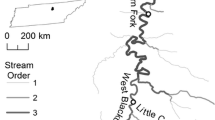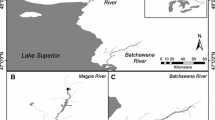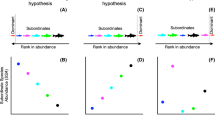Synopsis
Data on spatial variation of sculpin density, growth and fecundity support the hypothesis that populations of stream fish are structured by changes in risk of predation and prey availability along a gradient in stream size. Cottus bairdi in warm streams and C. cognatus in cold streams exhibit similar patterns. Sculpins in large streams have faster individual growth rates and higher fecundities than those in small streams, but occur at lower density. The patterns appear to be persistent and suggest that predation reduces sculpin density in larger streams. Competitive release, variations in prey productivity, and local factors probably contribute to the variation in sculpin growth.
Similar content being viewed by others
References cited
Alexander, G.R. 1979. Predators of fish in coldwater streams. pp. 153–170. In: H. Clepper (ed.) Predator-Prey Systems in Fisheries Management, Sport Fishing Institute, Washington, D.C.
Alstad, D.N. 1982. Current speed and filtration rate link caddisfly phylogeny and distributional patterns on a stream gradient. Science 216: 533–534.
Anderson, C.S. 1983. The influence of stream size on sculpin population dynamics. Ph.D. Thesis, The University of Michigan, Ann Arbor. 161 pp.
Bailey, J.E. 1952. Life history and ecology of the sculpin Cottus bairdi punctulatus in southwestern Montana. Copeia 1952: 243–254.
Balon, E.K. 1975. Reproductive guilds of fishes: a proposal and definition. J. Fish. Res. Board Can. 32: 821–864.
Baltz, D.M., P.B. Moyle & N.J. Knight. 1982. Competitive interactions between benthic stream fishes, riffle sculpin, Cottus gulosus, and speckled dace, Rhinichthys osculus. Can. J. Fish. Aquat. Sci. 39: 1502–1511.
Brett, J.R., J.E. Shelbourn & C.T. Shoop. 1969. Growth rate and body composition of fingerling sockeye salmon, Oncorhynchus nerka, in relation to temperature and ration size. J. Fish. Res. Board Can. 26: 2363–2394.
Brocksen, R.W., G.E. Davis & C.E. Warren. 1968. Competition, food consumption, and production of sculpins and trout in laboratory stream communities. J. Wildl. Mgmt. 32: 51–75.
Brown, L. & J.F. Downhower. 1982. Summer movements of mottled sculpins, Cottus bairdi (Pisces: Cottidae). Copeia 1982: 450–453.
Brownlee, K.A. 1965. Statistical theory and methodology in science and engineering. John Wiley and Sons, New York. 590 pp.
Crowder, L.B. & W.E. Cooper. 1982. Habitat structural complexity and the interaction between bluegills and their prey. Ecology 63: 1802–1813.
Fajen, O.F. 1962. The influence of stream stability on the homing behavior in two smallmouth bass populations. Trans. Amer. Fish. Soc. 91: 346–349.
Finger, T.R. 1982. Interactive segregation among three species of sculpins (Cottus). Copeia 1982: 680–694.
Fry, F.E.J. 1947. Effects of the environment on animal activity. Univ. Toronto Studies Biol. Ser. 55: 1–62.
Gorman, O.T. & J.R. Karr. 1978. Habitat structure and stream fish communities. Ecology 59: 507–515.
Hann, H.W. 1927. The history of the germ cells of Cottus bairdi Girard. J. Morph. Physiol. 43: 427–497.
Harrel, R.C., B.J. Davis & T.C. Dorris. 1967. Stream order and species diversity of fishes in an intermittent Oklahoma stream. Amer. Midl. Nat. 78: 428–436.
Hawkins, C.P., M.L. Murphy, N.H. Anderson & M.A. Wilzbach. 1983. Density of fish and salamanders in relation to riparian canopy and physical habitat in streams of the northwestern United States. Can. J. Fish. Aquat. Sci. 40: 1173–1185.
Horwitz, R.J. 1978. Temporal variability patterns and the distributional patterns of stream fishes. Ecol. Monogr. 48: 307–321.
Knutilla, R.L. 1967. Flow characteristics of Michigan streams. U.S.G.S., Water Resource Division, Lansing, Michigan. 337 pp.
Koster, W.J. 1937. The food of sculpins (Cottidae) in central New York. Trans. Amer. Fish. Soc. 66: 374–382.
Larimore, R.W., W.F. Childers & C. Heckrotte. 1959. Destruction and re-establishment of stream fish and invertebrates affected by drought. Trans. Amer. Fish. Soc. 88: 261–285.
Ludwig, G.M. & E.L. Lange. 1975. The relationship of length, age, and age-length interaction to the fecundity of the northern mottled sculpin, Cottus b. bairdi. Trans. Amer. Fish. Soc. 104: 64–67.
Ludwig, G.M. & C.R. Norden. 1969. Age, growth and reproduction of the northern mottled sculpin (Cottus bairdi bairdi) in Mt. Vernon Creek, Wisconsin. Milwaukee Public Museum, Occ. Pap. Nat. Hist. 2: 1–67.
Mahon, R. 1980. Accuracy of catch-effort methods for estimating fish density and biomass in streams. Env. Biol. Fish. 5: 343–360.
Mason, J.C. & S. Machidori. 1976. Populations of sympatric sculpins, Cottus aleuticus and Cottus asper, in four adjacent salmon-producing coastal streams on Vancouver Island, B.C. U.S. Fish. Bull. 74: 131–141.
Matthews, W.J. & J.T. Styron, Jr. 1981. Tolerance of headwater vs. mainstream fishes for abrupt physicochemical changes. Amer. Midl. Nat. 105: 149–158.
McCormick, J.H., K.E.F. Hokanson & B.R. Jones. 1972. Effects of temperature on growth and survival of young brook trout, Salvelinus fontinalis. J. Fish. Res. Board Can. 29: 1107–1112.
Minshall, G.W., R.C. Peterson, K.W. Cummins, T.L. Bott, J.R. Sedell, C.E. Cushing & R.L. Vannote. 1983. Interbiome comparison of stream ecosystem dynamics. Ecol. Monogr. 53: 1–25.
Moyle, P.B. 1977. In defense of sculpins. Fisheries 2: 20–23.
Newbold, J.D., R.V. O'Neill, J.W. Elwood & W. van Winkle. 1982. Nutrient spiralling in streams: implications for nutrient limitation and invertebrate activity. Amer. Nat. 120: 628–652.
Otto, R.G. & J.O. Rice. 1977. Responses of a freshwater sculpin (Cottus cognatus gracilis) to temperature. Trans. Amer. Fish. Soc. 106: 89–94.
Power, M.E. 1983. Grazing responses to tropical freshwater fishes to different scales of variation in their food. Env. Biol. Fish. 9: 103–115.
Schlosser, I.J. 1982. Fish community structure and function along two habitat gradients in a headwater stream. Ecol. Monogr. 52: 395–414.
Scott, W.B. & E.J. Crossman. 1973. Freshwater fishes of Canada. Fisheries Research Board of Canada Bull. 184: 1–966.
Sheldon, A.L. 1968. Species diversity and longitudinal succession in stream fishes. Ecology 49: 193–198.
Shelford, V.E. 1911. Ecological succession. I. Stream fishes and the method of physiographic analysis. Biological Bulletin 21: 9–35.
Smith, G.R. 1981. Effects of habitat size on species richness and adult body sizes of desert fishes. pp. 125–171. In: R.J. Naiman & D.L. Soltz (ed.) Fishes in North American Deserts, John Wiley and Sons, New York.
Smith, G.R., J.N. Taylor & T.W. Grimshaw. 1981. Ecological survey of fishes in the Raisin River drainage, Michigan. Michigan Academician 13: 275–305.
Sokal, R.R. & F.J. Rohlf. 1969. Biometry. W.H. Freeman, San Francisco. 776 pp.
Stalnaker, C.B. 1979. The use of habitat structure preferenda for establishing flow regimes necessary for maintenance of fish habitat. pp. 321–338. In: J.V. Ward & J.A. Stanford (ed.) The Ecology of Regulated Streams, Plenum Press, New York.
Stein, R.A. & J.J. Magnuson. 1976. Behavioral response of crayfish to a fish predator. Ecology 57: 751–761.
Vannote, R.L., G.W. Minshall, K.W. Cummins, J.R. Sedell & C.E. Cushing. 1980. The river continuum concept. Can. J. Fish. Aquat. Sci. 37: 130–137.
Van Vliet, W.H. 1964. An ecological study of Cottus cognatus Richardson in northern Saskatchewan. M.A. Thesis, University of Saskatchewan, Saskatoon. 155 pp.
Ware, D.M. 1972. Predation by rainbow trout (Salmo gairdneri): the influence of hunger, prey density, and prey size. J. Fish. Res. Board Can. 29: 1193–1201.
Whiteside, B.G. & R.M. McNatt. 1972. Fish species diversity in relation to stream order and physicochemical conditions in the Plum Creek drainage basin. Amer. Midl. Nat. 88: 90–101.
Zippin, C. 1956. An evaluation of the removal method of estimating animal populations. Biometrics 12: 163–189.
Author information
Authors and Affiliations
Rights and permissions
About this article
Cite this article
Anderson, C.S. The structure of sculpin populations along a stream size gradient. Environ Biol Fish 13, 93–102 (1985). https://doi.org/10.1007/BF00002577
Received:
Accepted:
Issue Date:
DOI: https://doi.org/10.1007/BF00002577




